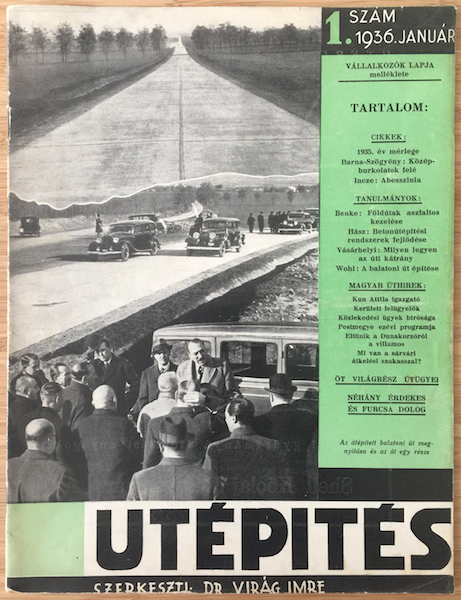
Description:
Utepites - Road Construction is an original 1935 vintage Hungarian magazine with a Modernist photomontage cover designed by Imre Gondor (Emerich Gondor or Emery I. Gondor).
Gondor was working for Ullstein Verlag in Berlin at the time, emigrated to the United States the same year. Previously, he lived in Budapest and Vienna, and was active in a wide variety of fields.
Emerich (Emery) I. Gondor (1896-1977) was born in Budapest, Hungary to Karoly and Henriette (née Fried) Gondor. He attended the Royal Hungarian University and received his diploma from the National Academy of Art. As a young art teacher, he observed many children who had suffered during and after World War I and was inspired to learn more about their afflictions and the ways in which art could be used to help them. This prompted a lifelong interest in the field of psychology.
In Budapest, the psychoanalyst Sándor Ferenczi introduced Gondor to the subject of psychoanalysis and therapy. When Gondor moved to Vienna in 1920, to attend the Academy of Industrial Arts, he learned of Professor Csizeck's pioneering work in the field of progressive art education for children. He began working at the Viennese University Clinic, drawing and playing with emotionally disturbed children. From 1925 to 1926, Gondor attended seminars in Berlin and participated in the work of the Individual Psychological Association. He exhibited his own oil paintings during those years, lectured and worked as an illustrator for children's books and several newspapers. He was also named to the post of art director at Ullstein, Europe's largest publishing house.
Gondor immigrated to the United States in 1935 and became a citizen in 1941. During World War II, he worked for the War Department and was Chief of the Technical Operation Unit in the Overseas Service for France and Germany for two years. This unit performed classified work in counter-espionage. Gondor was also an instructor at the training schools in New York, France and Germany, where he taught about the psychological problems of counter-espionage as well as wrote several classified manuals on the subject.
After the war, Gondor was named head of the art and play therapy groups at the Retarded Children's Clinic and the Psychiatric Child Guidance Clinic at New York Medical College. In addition, he wrote and illustrated several books, created puzzles for dozens of comic books, and taught art to juvenile delinquents at Youth House.
In 1959, Gondor received his diploma in Clinical Psychology from New York State University. He became director of the art program at the Institute for Mental Retardation at New York Medical College in 1968. Emery Gondor died in 1977. (source: http://digifindingaids.cjh.org/?pID=1369065)











